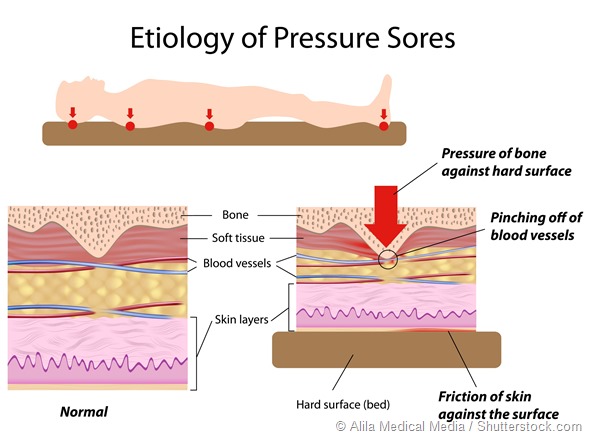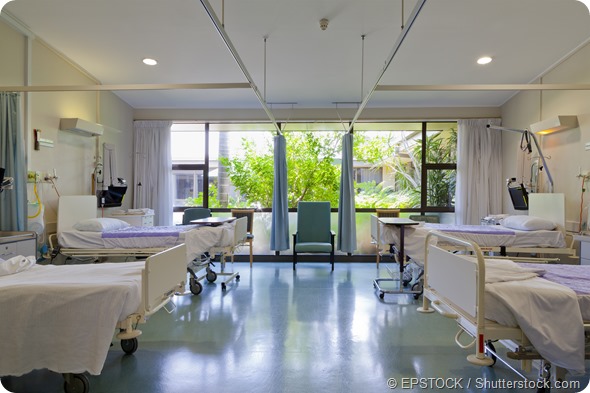What causes pressure ulcers and who do they affect?
Pressure ulcers are wounds that occur when a continuous pressure or friction is placed on one area of the body, damaging the skin. They occur when pressure stops blood from flowing normally, leading the cells to die and the skin to break down.

Pressure ulcers tend to affect people with health conditions that make it difficult to move, especially those confined to lying in a bed or sitting for prolonged periods of time.
Body parts that are most at risk of developing pressure ulcers are those that are not covered by a large amount of body fat and are in direct contact with a supporting surface, such as a bed or a wheelchair. These areas include; shoulders or shoulder blades, elbows, back of the head, rims of the ears, knees, ankles, heels or toes or spine.

Why are pressure ulcers a rising problem around the world?
Elderly people are at a higher risk of developing pressure sores because they have thinner skin, resulting in increased vulnerability to the damage caused by minor pressure. As such, if this pressure is continuous, a pressure sore can quickly develop.
With an aging population, pressure ulcers are a rising problem globally and in the UK alone, they affect over 700,000 people a year, adding an additional £4,000 per ulcer onto each patient’s care bill.
Pressure ulcers are also linked to prolonged hospitalization, pain, social isolation and in worst cases, death, which is why it is so important that patients, especially elderly ones who are bed bound or immobile, are treated on the most appropriate mattress.

Can you please explain the technology used in Rober’s mattresses?
Our technology creates a wave-like ripple effect that is specifically designed to replicate the body’s natural movements, helping to eliminate pressure injuries and provide patient comfort and safety.
This wave-like ripple effect provides regular and complete pressure elimination to all parts of the body that come into contact with the mattress, preventing pressure injuries from developing, as well as promoting the healing of established ulcers.
Over the last few years, heavy investment in R&D has enabled us to develop a full range of alternating mattress solutions, which cater for a variety of patients’ needs - from everyday nursing environments to acute care facilities.
We have solutions that cater for immobile, critically ill and bariatric patients, as well as those that have independent areas, such as the heel - a key risk area for pressure ulcers.
How does this technology help to eliminate pressure injuries?
Our new generation of mattresses are fully automatic and patients nursed upon them require less manual repositioning which helps in nursing environments.
The constant movement of the mattress ensures that patients are not affected by prolonged periods of pressure and therefore at risk of developing pressure injuries.
Through working closely with clinicians, we have focused our technology on four key areas - microclimate control, patient safety and comfort, maximizing infection control and offering additional nursing support.
Additional features such as a touch screen display panel, comfort settings, timed static mode, audible and visual alarms, and permanently inflated side formers all provide great benefits to patients and busy nursing staff.
What more needs to be done to prevent pressure ulcers around the world?
Education is the key. It is estimated that 80 – 95% of pressure are avoidable, so through educational programs, training and campaigns such as ‘Stop the Pressure’ and worldwide STOP the Pressure Day pressure ulcers can be dramatically reduced.
Access to technology is also a key factor. We believe that all healthcare establishments, wherever they are in the world, should have access to pressure ulcer technology to prevent their patients from developing pressure ulcers.
To help cater for this market, we have developed a secondary ‘cost effective’ range of mattress solutions designed to fulfill the requirements of ‘affordable healthcare’.
Through attending numerous congresses around the world and working with distributors in each country, we aim to raise the profile and awareness of these technologies worldwide.
What are Rober’s plans for the future?
Our R&D team is currently developing a third range of pressure solutions for Third World countries, which are more affordable. We hope that by providing undeveloped countries with access to this technology and by working with hospitals directly in these countries, it will help tackle the problem of pressure ulcers globally.
As a UK manufacturer, it is important to continually identify innovative solutions to assist our growth; therefore we are significantly investing in R&D and research activities/collaborative working to ensure that we stay at the forefront of technology.
We hope that the outcome of this work is increased profitability through improved quality and operations, increased sales and access to new markets.
Where can readers find more information?
www.roberlimited.com
About Mike Hutson
Studied Mechanical and Production Engineering along with Quality Assurance with the Ministry of Defense Research and Development focusing on weapon systems and fighting vehicles.
Worked for Thyssen Krupp Elevators as a Senior Manager of Operations for 12 years
Ran a multi-fuel stove burning company for 4 years on the South Coast UK before returning to the East Midlands.
- Started at Speed Plastics Ltd in 1997 and after a management buyout in 1999 became MD of the company. Speed Plastics are specialists in high frequency welding and manufacture flexible plastics, PVC, polyurethane and polyurethane coated textiles
- In 2008 Mike bought pressure ulcer company Rober Ltd. Both companies are based in Chesterfield, Derbyshire. Over the last few years Mike as invested heavily in R&D and has developed a full range of pressure ulcer mattress solutions. All the mattresses are designed and manufactured in the UK and are distributed around the globe via a network of partners.